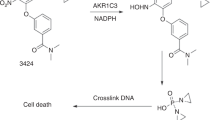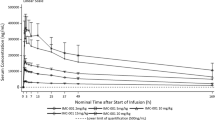Summary
Introduction VLX600 is a novel iron chelator designed to interfere with intracellular iron metabolism, leading to inhibition of mitochondrial respiration and bioenergetic catastrophe and resultant tumor cell death. Methods We conducted a multicenter, phase 1, dose escalation study to determine the safety and adverse event profile and the maximum tolerated dose and recommended phase 2 dose of VLX600. Other endpoints included pharmacokinetics, and preliminary evidence of anti-cancer efficacy as assessed according to RECIST 1.1 criteria. VLX600 was administered intravenously on days 1, 8, and 15 of each 28-day treatment cycle. Results Nineteen patients were enrolled, and seventeen received at least one dose of VLX600. Dose increments were reduced to 50% after dose level 3 (40 mg) due to the occurrence of a grade 3 pulmonary embolism. The study was then closed early due to slow recruitment. No maximum tolerated dose (MTD) nor RP2D had been identified at the time of study closure. Overall, the drug was well tolerated and no DLTs were observed. Fourteen patients experienced drug-related adverse events of any grade. The most frequently reported drug-related AEs were fatigue, nausea, constipation, vomiting, increased alkaline phosphatase, anemia, and decreased appetite. No formal efficacy or survival analyses were performed. No objective responses were observed, though six patients (32%) had stable disease as best response. Conclusion VLX600 was reasonably well tolerated and, together with preclinical data, there is support for further efforts to explore its activity as single agent and in combination with drugs or radiation.



Similar content being viewed by others
References
Mellor HR, Callaghan R (2008) Resistance to chemotherapy in cancer: a complex and integrated cellular response. Pharmacology 81(4):275–300
Harris AL (2002) Hypoxia--a key regulatory factor in tumour growth. Nat Rev Cancer 2(1):38–47
Sahin AA, Ro JY, el-Naggar AK et al (1991) Tumor proliferative fraction in solid malignant neoplasms. A comparative study of Ki-67 immunostaining and flow cytometric determinations. Am J Clin Pathol 96(4):512–519
St Croix B, Flørenes VA, Rak JW et al (1996) Impact of the cyclin-dependent kinase inhibitor p27Kip1 on resistance of tumor cells to anticancer agents. Nat Med 2(11):1204–1210
Gardner LB, Li Q, Park MS, Flanagan WM, Semenza GL, Dang CV (2001) Hypoxia inhibits G1/S transition through regulation of p27 expression. J Biol Chem 276(11):7919–7926
Tannock IF (2001) Tumor physiology and drug resistance. Cancer Metastasis Rev 20(1–2):123–132
Kim JJ, Tannock IF (2005) Repopulation of cancer cells during therapy: an important cause of treatment failure. Nat Rev Cancer 5(7):516–525
Brown JM (1999) The hypoxic cell: a target for selective cancer therapy--eighteenth Bruce F. Cain Memorial Award lecture. Cancer Res 59(23):5863–5870
Finch RA, Liu M, Grill SP et al (2000) Triapine (3-aminopyridine-2-carboxaldehyde- thiosemicarbazone): a potent inhibitor of ribonucleotide reductase activity with broad spectrum antitumor activity. Biochem Pharmacol 59(8):983–991
Richardson DR (2002) Iron chelators as therapeutic agents for the treatment of cancer. Crit Rev Oncol Hematol 42(3):267–281
Lovejoy DB, Jansson PJ, Brunk UT, Wong J, Ponka P, Richardson DR (2011) Antitumor activity of metal-chelating compound Dp44mT is mediated by formation of a redox-active copper complex that accumulates in lysosomes. Cancer Res 71(17):5871–5880
Shao J, Zhou B, Di Bilio AJ et al (2006) A ferrous-Triapine complex mediates formation of reactive oxygen species that inactivate human ribonucleotide reductase. Mol Cancer Ther 5(3):586–592
Zhang X, Fryknäs M, Hernlund E et al (2014) Induction of mitochondrial dysfunction as a strategy for targeting tumour cells in metabolically compromised microenvironments. Nat Commun 5:3295
Eisenhauer EA, Therasse P, Bogaerts J et al (2009) New response evaluation criteria in solid tumours: revised RECIST guideline (version 1.1). Eur J Cancer 45(2):228–247
Lawen A, Lane DJ (2013) Mammalian iron homeostasis in health and disease: uptake, storage, transport, and molecular mechanisms of action. Antioxid Redox Signal 18(18):2473–2507
Merlot AM, Kalinowski DS, Richardson DR (2013) Novel chelators for cancer treatment: where are we now? Antioxid Redox Signal 18(8):973–1006
Yu Y, Kovacevic Z, Richardson DR (2007) Tuning cell cycle regulation with an iron key. Cell Cycle 6(16):1982–1994
Le NT, Richardson DR (2002) The role of iron in cell cycle progression and the proliferation of neoplastic cells. Biochim Biophys Acta 1603(1):31–46
Andrews NC (2000) Iron homeostasis: insights from genetics and animal models. Nat Rev Genet 1(3):208–217
Yuan J, Lovejoy DB, Richardson DR (2004) Novel di-2-pyridyl-derived iron chelators with marked and selective antitumor activity: in vitro and in vivo assessment. Blood 104(5):1450–1458
Whitnall M, Howard J, Ponka P, Richardson DR (2006) A class of iron chelators with a wide spectrum of potent antitumor activity that overcomes resistance to chemotherapeutics. Proc Natl Acad Sci U S A 103(40):14901–14906
Defamie N, Chepied A, Mesnil M (2014) Connexins, gap junctions and tissue invasion. FEBS Lett 588(8):1331–1338
Jansson PJ, Sharpe PC, Bernhardt PV, Richardson DR (2010) Novel thiosemicarbazones of the ApT and DpT series and their copper complexes: identification of pronounced redox activity and characterization of their antitumor activity. J Med Chem 53(15):5759–5769
Knox JJ, Hotte SJ, Kollmannsberger C, Winquist E, Fisher B, Eisenhauer EA (2007) Phase II study of Triapine in patients with metastatic renal cell carcinoma: a trial of the National Cancer Institute of Canada clinical trials group (NCIC IND.161). Investig New Drugs 25(5):471–477
Kunos CA, Winter K, Dicker AP et al (2013) Ribonucleotide reductase expression in cervical cancer: a radiation therapy oncology group translational science analysis. Int J Gynecol Cancer 23(4):615–621
Funding
The study reported herein was supported by Vivolux AB.
Author information
Authors and Affiliations
Corresponding author
Ethics declarations
Conflict of interest
Kabir Mody:
Research Support) Senwha Biociences Inc., Tracon Pharmaceuticals, Genentech; Astrazeneca/Medimmune; Arqule, Inc.; Agios; Taiho Oncology; Boston Biomedical; Ipsen.
Consulting/Advisory Board) Eisai Co, Ltd., Bayer Pharmaceuticals.
Mitesh Borad:
Research Support) Boston Biomedical, miRNA Therapeutics, Senwha Biociences Inc., Astrazeneca/Medimmune, BiolineRx, Agios, Halozyme, Celgene, Threshold Pharmaceuticals, Toray Industries, Dicerna, Sillajen, Eisai, Taiho Pharmaceuticals, EMD Serono, Isis Pharmaceuticals, Incyte, Sun Biopharma, Ariad, ImClone Systems, QED Therapeutics.
Consulting/Advisory Board) G1 Therapeutics, TD2, Fujifilm, Agios, Insys Therapeutics, Novartis, ArQule, Celgene, Inspyr Therapeutics, Halozyme, Pieris Pharmaceuticals, Taiho Pharmaceuticals.
Stock and Other Ownership Interests) GlaxoSmithKline, Gilead Sciences, AVEO.
Travel, Accomodations, Expenses) ArQule, Celgene, Astrazeneca.
Aaron Mansfield:
Research Support) NIH, Novartis and Verily.
Consulting/Advisory Board) Honoraria are paid to institution for participation in advisory boards for Abbvie, BMS and Genentech.
Peter Nygren: shareholder in Vivolux AB.
Joachim Gulbo: shareholder in and consultant to Vivolux AB.
All other authors have no relevant conflicts of interest to disclose.
Ethical approval
All procedures performed in studies involving human participants were in accordance with the ethical standards of the institutional and/or national research committee and with the 1964 Helsinki declaration and its later amendments or comparable ethical standards.
Informed consent
Informed consent was obtained from all individual participants included in the study.
Rights and permissions
About this article
Cite this article
Mody, K., Mansfield, A.S., Vemireddy, L. et al. A phase I study of the safety and tolerability of VLX600, an Iron Chelator, in patients with refractory advanced solid tumors. Invest New Drugs 37, 684–692 (2019). https://doi.org/10.1007/s10637-018-0703-9
Received:
Accepted:
Published:
Issue Date:
DOI: https://doi.org/10.1007/s10637-018-0703-9




